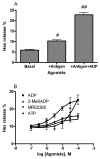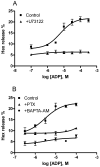P2Y(13) receptor is responsible for ADP-mediated degranulation in RBL-2H3 rat mast cells
- PMID: 20813187
- PMCID: PMC2974784
- DOI: 10.1016/j.phrs.2010.08.003
P2Y(13) receptor is responsible for ADP-mediated degranulation in RBL-2H3 rat mast cells
Abstract
Extracellular ADP is known to play many important physiological roles. In this study, we identified the P2Y(13) receptor in a rat mast cell line (RBL-2H3) and explored the functional role of ADP, its endogenous agonist. ADP induced both intracellular calcium mobilization and release of hexosaminidase (Hex). In an assay of intracellular calcium, ADP was 100-fold less potent than and equally efficacious as the P2Y(1) receptor-selective agonist MRS2365. However, ADP was more potent and efficacious than MRS2365 in inducing Hex release and in enhancing antigen-induced Hex release. ADP-induced intracellular calcium mobilization was blocked by phospholipase C inhibitor U73122 and by P2Y(1) receptor-selective antagonist MRS2500, but not by pertussis toxin (PTX), suggesting a mechanism mediated by the G(q)-coupled P2Y(1) receptor, but not P2Y(13) (G(i)-coupled) or P2X receptors. ADP-induced Hex release was blocked by PTX and a selective P2Y(13) receptor antagonist MRS2211, but not by MRS2500 or P2Y(1) receptor-specific siRNA, suggesting a G(i)-coupled P2Y(13) receptor-related mechanism. Measurement of gene expression confirmed high expression of both P2Y(1) and P2Y(13) receptors (in comparison to a previously reported P2Y(14) receptor) in RBL-2H3 cells. Thus, we demonstrated that ADP-mediated intracellular calcium mobilization and Hex release in RBL-2H3 cells are via P2Y(1) and P2Y(13) receptors, respectively. Selective antagonists of the P2Y(13) receptor might be novel therapeutic agents for various allergic conditions.
Published by Elsevier Ltd.
Figures








Similar articles
-
The role of P2Y(14) and other P2Y receptors in degranulation of human LAD2 mast cells.Purinergic Signal. 2013 Mar;9(1):31-40. doi: 10.1007/s11302-012-9325-4. Epub 2012 Jul 24. Purinergic Signal. 2013. PMID: 22825617 Free PMC article.
-
UDP-glucose acting at P2Y14 receptors is a mediator of mast cell degranulation.Biochem Pharmacol. 2010 Mar 15;79(6):873-9. doi: 10.1016/j.bcp.2009.10.024. Epub 2009 Nov 5. Biochem Pharmacol. 2010. PMID: 19896471 Free PMC article.
-
Cross talk between P2 purinergic receptors modulates extracellular ATP-mediated interleukin-10 production in rat microglial cells.Exp Mol Med. 2008 Feb 29;40(1):19-26. doi: 10.3858/emm.2008.40.1.19. Exp Mol Med. 2008. PMID: 18305394 Free PMC article.
-
The P2 receptors and congenital platelet function defects.Semin Thromb Hemost. 2005 Apr;31(2):168-73. doi: 10.1055/s-2005-869522. Semin Thromb Hemost. 2005. PMID: 15852220 Review.
-
Pharmacological profiles of cloned mammalian P2Y-receptor subtypes.Pharmacol Ther. 2006 Jun;110(3):415-32. doi: 10.1016/j.pharmthera.2005.08.014. Epub 2005 Oct 28. Pharmacol Ther. 2006. PMID: 16257449 Review.
Cited by
-
Enteric glia promote visceral hypersensitivity during inflammation through intercellular signaling with gut nociceptors.Sci Signal. 2023 Nov 21;16(812):eadg1668. doi: 10.1126/scisignal.adg1668. Epub 2023 Nov 21. Sci Signal. 2023. PMID: 37988454 Free PMC article.
-
Pharmacological interaction and immune response of purinergic receptors in therapeutic modulation.Purinergic Signal. 2024 Aug;20(4):321-343. doi: 10.1007/s11302-023-09966-7. Epub 2023 Oct 16. Purinergic Signal. 2024. PMID: 37843749 Free PMC article. Review.
-
The role of P2Y(14) and other P2Y receptors in degranulation of human LAD2 mast cells.Purinergic Signal. 2013 Mar;9(1):31-40. doi: 10.1007/s11302-012-9325-4. Epub 2012 Jul 24. Purinergic Signal. 2013. PMID: 22825617 Free PMC article.
-
Decoding the Mechanism behind the Pathogenesis of the Focal Segmental Glomerulosclerosis.Comput Math Methods Med. 2022 Apr 19;2022:1941038. doi: 10.1155/2022/1941038. eCollection 2022. Comput Math Methods Med. 2022. Retraction in: Comput Math Methods Med. 2023 Dec 6;2023:9812513. doi: 10.1155/2023/9812513. PMID: 35693262 Free PMC article. Retracted.
-
Activation of the P2Y1 receptor induces apoptosis and inhibits proliferation of prostate cancer cells.Biochem Pharmacol. 2011 Aug 15;82(4):418-25. doi: 10.1016/j.bcp.2011.05.013. Epub 2011 May 23. Biochem Pharmacol. 2011. PMID: 21632028 Free PMC article.
References
Publication types
MeSH terms
Substances
Grants and funding
LinkOut - more resources
Full Text Sources
Other Literature Sources
Molecular Biology Databases

